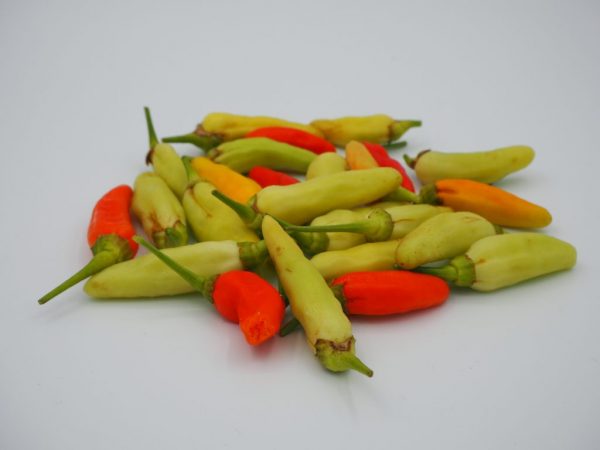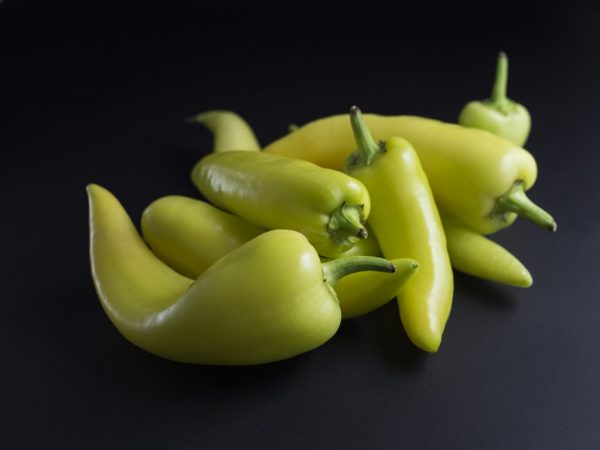Characteristics of Belozerka pepper
Belozerka pepper is considered one of the most popular varieties of this crop. All agricultural firms are engaged in the supply of seeds of the variety. Among the most attractive characteristics of the variety, resistance to most diseases is noted.

Pepper Belozerka
Characteristic
Pepper Belozerka was bred in Russia in the Transnistrian region in 1991. In 1995, this variety was entered in the State Register of the Russian Federation. The original name of the hybrid is Lumina.
The plant is suitable for growing in all regions of the country. The variety shows ideal yield characteristics both in open areas and in greenhouse conditions.
Description of the bush
Sweet pepper Belozerka belongs to hybrid varieties. The growing season before the onset of technical ripeness is 110 days. Biological ripeness occurs on day 125.
The height of the determinant bush does not exceed 70 cm. For this reason, tying is not necessary. According to the description, the bush is half-stem. The plant has a large number of dark green leaves. The main stem and root system are well developed, which greatly simplifies maintenance.
Description of the fetus
According to the description, the described bell pepper has the following characteristics:
- the shape of the fruit resembles a geometric figure - a cone: the tip is always pointed;
- the color of the fruit is deep green (during technical maturity), with the onset of biological ripeness, the fruits change color to yellow or red;
- glossy surface;
- fruits have 2 sides;
- wall thickness is in the range of 0.5-0.7 cm (depending on the landing site);
- the mass of bell peppers of this variety is 150 g.
Each fruit contains a small amount of seeds that can be easily removed. Yield indicators: from 1 bush, farmers collect about 8 kg of products suitable for sale. The taste is sweet, without acidity or bitterness. The flesh of the fruit is firm and fleshy.
The Belozerka pepper variety belongs to the universal varieties. Due to its taste, it can be consumed fresh or used for preparing salads, because the pulp contains a large amount of vitamins of group C. It is also noted that the sweet taste preserves, even when preserved.
Growing seeds
First of all, you need to correctly approach the choice of seeds. Pay attention only to trusted sources of sale. After purchase, low-quality seeds are sifted out. To check the quality, the planting material is immersed in warm, settled water for half an hour. After some seeds float up, they are thrown away: they do not have the germination characteristic.
Selected seeds are soaked in a manganese solution for 15-20 minutes: this allows you to remove all harmful bacteria and trace elements from the seeds and increase the yield. It is also recommended to process the planting material with growth stimulants. After that, they begin to plant. To begin with, prepare the correct soil in containers.It should consist of 40% garden soil, 30% humus and 30% sand.
It is best to carry out planting work in March. Just by the beginning of May, when you need to plant the seedlings in a permanent place, they will be fully formed. Seeds of Belozerka pepper are immersed in the ground to a depth of 2 cm. This depth is quite enough for the development of the root system. The soil is thoroughly watered and the containers are placed in a warm, lighted place. All containers are covered with plastic wrap to increase seedling germination. The optimum temperature for fast germination of seeds is 25 ° C. Every day for 30 minutes the film is opened so that the seeds can receive the required amount of air. After the first shoots appear, the film is removed.
After removing the film, the containers are placed on the windowsill so that the plant receives the right amount of sunlight. Every day, the seedlings are turned to the light source on the other side: this allows them to form evenly. Watering the seedlings is carried out every 3 days.
Transplanting seedlings

Good pepper
Literally a few weeks before the intended planting of seedlings in open ground or a greenhouse, hardening is carried out. To do this, for 2 weeks, the seedlings are taken out daily. The first few days, she should stay on the street for no more than 2 hours. Starting from day 3, the time is gradually increased to 8 hours. This procedure is necessary for the plants to begin to get used to the environmental climate.
Planting in a permanent place is carried out only after the first ovaries appear on the seedlings. The air temperature should be in the range of 15-18 ° С. This is important for the proper formation of the root system (it cannot be overcooled).
The seedlings are moved into the holes with extreme care so as not to damage the roots. It is better to pour a little water into the hole and only then put the plant inside. After that, everyone is covered with earth, tamped a little and watered with 1 liter of warm water.
When transplanting seedlings, it is important to adhere to the correct planting scheme.
- The hole should be about 8 cm wide (for normal root development).
- A distance of 50 cm should be adhered to between the rows.
- The distance between the holes should be 60 cm.
Care
So that the weeds do not interfere with the plant and a crust from the earth does not form around, the space between the holes is mulched. For this, a mixture of straw and humus is used. Watering is carried out in the morning with warm water (25 ° C). For the first few weeks, sprayers are used for watering. Starting from the 25th day, watering is carried out by the drip method, exclusively at the root.
Top dressing is carried out by alternating organic matter and mineral fertilizers. Immediately after planting, the plant is fed with bird droppings. During the formation of ovaries, nitrogen substances are used to speed up the process. During the fruiting period, phosphorus and potassium substances are used to improve the appearance and taste of the fruit.
Diseases and parasites
The Belozerka variety of sweet pepper is resistant to diseases such as verticillium, tobacco mosaic and late blight. A strong immune system is an undoubted advantage of the variety.
The plant is affected by aphids and spider mites. You can fight these pests with the help of chemical insecticides or folk remedies. For aphids, it is better to use medicinal preparations (Oxyhom or Tabbu) or solutions of garlic or onion peels. Against spider mites, the use of the drug Antik or tincture of cayenne hot pepper is recommended.
Conclusion
The Bulgarian vegetable Belozerka has all the advantages that attract gardeners. First, it doesn't require much maintenance. Secondly, the presence of canceled immunity keeps it at the top of the vegetable market. If you grow this variety on the site, literally in 3 months you can enjoy healthy and tasty fruits of high quality.

